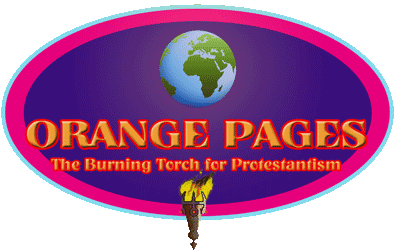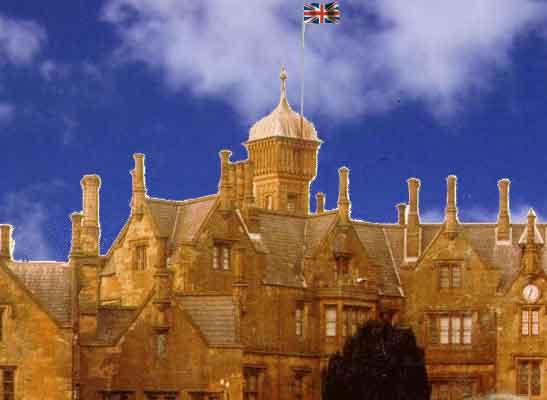
 |
Brownlow House, Lurgan

|
Brownlow House or Lurgan Castle, so named presumably after the Rt. Hon. Charles Brownlow, who built it in 1833, was created Baron Lurgan in 1839, was owned by the Brownlow family until the turn of the century. Changing fortunes resulted in the property being sold to the Lurgan Real Property Company Ltd. and subsequently the House and surrounding grounds were purchased on behalf of Lurgan Loyal Orange District Lodge. The legal document of conveyance is dated 11 July 1904. In appreciation of the effort of the late Sir William Allen, KBE, DSO, DL, MP in obtaining the House, an illuminated address was presented to him by District Lodge and now hangs in the Dining Room beside the portrait of Sir William painted by Frank McKelvey. He together with Messrs. Hugh Hayes, John Mehaffey, George Lunn Jun. and James Malcolm Jun. were the first Trustees. Not only does Brownlow House claim' to be the largest Orange Hall in the world but as the headquarters of the Imperial Grand Black Chapter of the British Commonwealth, it is in fact well known throughout the world.
Brownlow House, built in an age of grandeur and cultured tastes, is an imposing building. It has retained much of the atmosphere of bygone days and one can readily pause and still imagine what life was like when it was occupied as a dwelling. While the echo of successive Brownlow Households along its corridors has long since died away, the building has however remained alive ever since it became the home of Orangeism in Lurgan almost one hundred years ago. Situated within a few minutes walk from the centre of the town, the House is a prominent land mark with its lantern-shaped tower and forest of tall chimneys dominating the skyline. It commands a fine view across the park and lake, which were once part of Lord Lurgans estate and are now owned by Craigavon Borough Council. The building which is of Scottish sandstone was designed in the Elizabethan style by the famous Edinburgh Architect, William Henry Playfair and it was recently listed by the Department of Environment (NI) as being of special architectural and historical interest. (The collection of Playfair's 383 drawings of the House are in Edinburgh University Library.) The elegant wrought iron entrance gates are also listed. Originally the entrance to the avenue started at Market Street where there was a stone-arched gateway and lodge house, but no trace of either remains today. Likewise Castle Lane, where the previous Lurgan Orange Hall Building had stood has also been demolished with other houses once occupied by many of the tradesmen employed by the Brownlows.
The House contains many interesting features. The walls of the octagon shaped reception room for instance have some of the finest examples of vert-antique marble plaster, panelled and painted by Italian craftsmen. The ceilings of several rooms are grained to represent expensive wood and over the grand staircase carved from native oak, there is a beautiful example of free brush work in the ceiling panels. Four heraldic shields of the McNeill, Kilmaine, Brownlow and Dornley families, who were related by marriage, adorn the ceiling of the entrance hallway and these same armorial bearings together with the crests, are executed as eight stained glass windows on the grand staircase. The House also had a warm air heating system ducted from a furnace in the basement.
The early history of Lurgan has been associated with the Brownlow family since the plantation of Ulster. Lurgan is derived from the name Lurganballyvacken or Ballylurgan. John Brownlow and his son, William, came from Basford near Nottingham when they were granted 2500 acres of land in the barony of O'Neiland East by James 1 in 1610. Carew in his Report of 1611 records that John and William Brownlow were both resident and dwelling in an "Irish House". They had brought over six carpenters, one mason, one tailor and six workmen and had placed one freeholder and six tenants upon their lands. Prepa-rations were being made to build two bawns and they had some muskets and other arms in readiness for defence of the properties. By 1619 John Brownlow was dead and William came into posses-sion of the two manors. Pynnar's "Survey" of that year states that there was "upon Ballynemony a strong stone house within a good island and at Doughcoron a fair house of stone and brick with a bawn of timber and earth with a pallazado about it and in readiness lime and stone to make a bawn thereof in the summer". There was then a very fair town consisting of forty-two houses, all inhabited by English families, with streets paved clean through. There were also two water-mills and a wind mill, all for corn, and a store of arms in the manor. In 1629 William had a re-grant of the two manors by which they became united as the Manor of Brownlow's Derry. At the same time a patent was issued for a market every Friday at Ballylurgan and two fairs on the Feast of St. James and Feast of St. Martin. By this time the town had become a place of importance in the social life of the area and gives Lurgan's markets and fairs an ancestry of over three hundred and twenty years.
In 1641 the Civil War broke out and Lurgan was taken by a force of native soldiers said to have numbered 1,000 men. From Carte's "Life of Ormonde" the outbreak was not entirely unexpected for Sir William Brownlow had been supplied with powder for the defence of his Castle. The attack took place on the 23rd October, 1641 (in his later account he changed the date to l st November) and the raiding par-ties under the Macans, Magennises and the O'Hanlons burnt the town and murdered several inhabitants. The Castle surrendered and Brownlow was taken prisoner with his wife and children, first to Armagh, later to Dungannon and finally to Charlemont where he was eventually freed by the English. According to O'Mellan's Jour-nal there was a second burning of Lurgan in May 1642. The town seems to have suffered little inconvenience during the Williamite Wars. Some of Schomberg's troops were stationed in the town and neighbourhood and the General made them responsible for the repair of the highway, with, of course, an ulterior object in view - the facility of his troops when the occasion should arise. Tra-dition says that during this work the General once used the Blue Stone at Lylo as a luncheon table. The famous landmark is now buried.
In the closing years of the 17th century Lurgan began to develop as a linen manufacturing centre and Dr Thomas Molyneaux (of Castledillon) in his book "Journey to ye north" written in 1708 de-scribes the town "at present the greatest mart of linen manufacturers in the north being almost entirely peopled with linen weavers, and all by the care and cost of Mr Brownlow, who on his first establish-ing the trade here, bought up everything brought to the market of cloth (linen) and lost at first considerably, but at length the thing fixing itself, he is now by the same methods a considerable gainer. This gentleman is more curious than ordinary and has by him sev-eral old Irish manuscripts which he can read and understand very well. He shewed me one in parchment of the Bible (as I remember) pretended to be written by St. Patrick's own hand but this must be a fable. This gentleman is not satisfied about the petrifying qualities of Lough Neagh waters .... Having supped with him we lay at an Inn." In 1712 James Quin of Carlow was induced by William Brownlow to take up his abode in Lurgan and begin the manufacture of damask and by 1714 fine cambric was being produced in the district. At that time the making of linen was an essentially domestic affair. Farmers grew the flax on their wn lands and it was scutched at home. The families then combined to spin the effected by the same hands. From Young's Tour Of Ireland published in 1780, the writer mentions the great improvements Mr Brownlow had made in his demesne. Although mainly concerned with agriculture but being in the town on a Market Day he walked to the mart to see the way which linens and cambrics were sold and gives an excellent account of the Proceedings. Weavers were able to earn by coarse linens 1/-per day and by fine 1/4d, and the same applied to the spinners - they received more for the fine yarns. A Parcel of linen woven in 1809 was of such excellence that it was presented to Princess Charlotte; and later on Lurgan canibrics were sent to Queen Victoria. The town then boasted a handsome Market House situated in the old Middle Row, and a Line Hall built in 1825. Lurgan was the second town in the County in importance in 1819 and it contained 379 houses and 2207 inhabitants. The weekly trade in linen then averaging from £2,500 to £3,000 per week. The first power loom factory was built in 1855 by the Malcolms who, in the days of handloom weaving, had been engaged in the manufacture of cambric. The new venture was unpopular with the hand-loom weavers who gathered together on one occasion to wreck the plant. The Mechanics Institute was opened in 1858 and in 1865 the Liner, Hall was abolished. Owing to industrial changes it had outlived its usefulness. In 1866 the Malcolms also established the first hem-stitching factory in the town. Johnston, Allen & Co. was set up in 1867 for the manufacture of linen and cambric by handloom but transferred to power-loom weav-ing in 1888. In an account of Lurgan written in 1751 by the Rev. Richard Barton, there is a vivid representation of the Lurgan linen market. While the linens were sold in the open market they were measured under cover in the public houses and custom had made it a rule that the sellers of webs should expend at least three-pence in liquor for the good of the house. In 1793 the Irish Militia was re-organised and county units raised. Lurgan, possibly due to its geographical position, sent very few men into the Armagh Militia. Three years later Yeomanry Corps formed and Lurgan acquired a Cavalry and Infantry Corps - the latter in the next century became involved in certain squabbles of a political na-ture, whereby its loyalty to authority became suspect. Part of the trouble was due to the then agent who was very anti-Orange in his views. A coat of the Lurgan Corps survives in the National Mu-seum, Dublin, and very full records presented by the late Sir William Allen are preserved in Armagh Museum. In 1795 when the Orange Order was formed, its principles were quickly adopted in Lurgan. In 1797 the town was the place of meet-ing for the second demonstration since the Order's formation. Great preparations had been made. From sunrise that morning crowds of people were on their way. Districts west of the Bann joined together at Portadown where they were inspected by Major Acheson (later Lord Gosford) then a candidate for the county. About that time William Blacker of Carrickblacker received a present form his grand-uncle, Col. Carey, of some horse furniture used by King William at the battle of the Boyne, and the meeting was deemed a most fitting occasion for its exhibition. Blacker, accordingly, placed it upon a magnificent black hunter and escorted by twelve of the finest looking men in the country, all above six feet high and dressed alike, two of whom led the horse whilst the others tried to keep off the crowds who strove to touch the valued relics as they passed along. They were accompanied by several hundred well-mounted horse-men, many of whom had come from Killyman and other parts of Tyrone followed by the districts in their order with all manner of music. The story from this point had best be told in William Blacker's own words. "At Lurgan we were met by two other processions from Down and Antrim and there we found General Luke, the Commander-in-Chief of the Northern district, waiting to receive us, attended by one or two other General officers and their entire staff in full rig. We de-filed past these grandees near the head of the Castle Lane, down which we proceeded into Mr Brownlow's demesne and round the lake which was completely surrounded and more, the head of the procession having reached the street of Lurgan again ere the last had entirely quitted it. 1 do not recollect having ever since seen a sight so beautiful as the lake surrounded as it was upon that occasion by a slow moving processional mass. The day was extremely fine. The women gaily dressed were as numerous as the men. There was a marked sparkling of scarlet, the Yeomanry wearing their uniforms, the Banners, the music coming softened across the water, the gen-eral appearance of cheerful exultation, all conspired to form a scene which can never be obliterated from my memory. In less than two hours afterwards the town was cleared. My father and 1 dined there with a large party of gentlemen and on going home on horseback about ten at night 1 do not think we saw four people on the road between Lurgan and Carrick. One of these was old Frank Baird, a fiddle playing school-master from Drunilyn Hill, whom we came up with near the "Red Cow" fiddling and dancing a pass seul along the road which he actually kept up with unabated spirit until we reached the turn to Carrick and no doubt continued it the entire way to his domicile. It has frequently happened to me to traverse many miles of the country on the night of the 12th of July and 1 can safely assert that I invariably found the roads more quiet on that night than on any other. It seemed a point of honour among the Protestants to keep that night from becoming marked by an impropriety. Men whose conduct might be loose enough 364 nights in the year were on their guard on that one." In September 1912 the Ulster Covenant was signed at Brownlow House by thousands of Lurgan people and not a few were called to make the supreme sacrifice between 1914 and 1918. Many of them were Orange Brethren and their names are all recorded on the roll of honour at the town's war memorial. At the outbreak of the first World War, Brownlow House was the headquarters of the 16th Battalion Royal Irish Rifles and the 10th Battalion Royal Irish Fusiliers. The flag of the Old Comrades Association of the former Battalion and the Kings Colour of the 2nd Battalion of the Royal Irish Fusiliers are laid up in Shankill Parish Church. In the second World War that readiness to serve King and Country was again demonstrated and indeed more recently many have been serving in the defence of freedom and for the right to remain British. Various contingents of British and American troops were stationed in Lurgan between 1939 and 1945 and when the United States forces were billeted in Brownlow House, General Dwight D. Eisenhower, the Supreme Allied Commander is said to have spent at least one night there with his men. The corridor to the room in the House where he slept is still called the Officer's Corridor. One of the stained glass heraldic panes on the grand staircase was removed then reputedly by the Yanks as a memento of their stay. It has however been replaced by a replica. A few years before the re-organisation of local government took place in 1973 in Northern Ireland, the Trustees of Brownlow House were pleased to put part of the House at the disposal of Lurgan Borough Council, The RUC had requisitioned the Town Hall after the barracks in Church Place had been bombed by the IRA. The dining room of the House was used as the Council Chamber. The Brownlow family motto "Esse quam videri" surrounds the cipher letters WAB (William Arthur Brownlow) above the archway in this room. The Latin can be freely translated "To be, rather than to seem" and the sentiment is not unlike that of Lurgan Borough Council motto, which was "Be just and fear not", (Craigavon Borough Council's motto is "Together we progress") The first Lord Lurgan was one of the fourteen members elected to the newly formed Town Commissioners in 1843, the predecessors of Lurgan Urban and Borough Councils. The 4th Lord Lurgan in fact presented Lurgan Borough Council with the Mayoral chain of office. It incorporates the Brownlow armorial bearings. The link with the new Borough is perpetuated as the same chain is still is use and worn by the Mayor of Craigavon Borough Council. Further evidence of the Brownlow link with Lurgan is seen in Shankill Parish Church. The stained glass window on the south side the chan-cel, representing Faith, Hope and Charity was erected by the second Lord Lurgan in memory of his father. Shankill meaning the "old church" is a very ancient parish as the name implies. Documentary evidence traces its history back to 141 1, when the parish of Kilwilke was subsequently changed to "Kilymlcon" and later to "St Finton alias Caillmore". The church originally stood in the townland of Annaloiste on the shores of Lough Neagh to the north of Lurgan. When Lurgan developed, a site in the town for the Church of Shankill was found in what is now the old Shankill graveyard. This site is now occupied by the Brownlow family vault. In the intervening years with the increasing population a new site for the Church had to be obtained and with permission from the Irish parliament, it was built on the "Fair Green of Lurgan" The present Church was erected and consecrated on 8 August 1725. The spire, which had been added, was burned by a fire in 1792 and the wooden one that replaced it was blown down by the wind one stormy evening in 1839. Enlarged in 1832 at a cost of £1,000 it was subsequently taken down to allow the present building to be erected in 1863. The new Church cost £8,000 and is reputed to be the larg-est Parish Church in Ireland, capable of seating almost 2,000 peo-ple. The only relic from the old Church in Shankill graveyard transferred were the stone baptismal font, dated 1684, and the silver communion vessels made in 1696. Lurgan like other towns of Northern Ireland has had its share of sectarian violence and vandalism. The murder of the young Soldier, Private Paul Genge by the IRA on 7th November 1971 near the hospital was the first of many tragic deaths in and around our town, Good men and women, as they endeavour to maintain law and order have been severely tried and tested in the cause of Civil and Religious liberty. The destruction of property which has been widespread has included Brownlow House. There have been at least three serious attempts to burn it. The wing occupied by the Imperial Grand Black Chapter was destroyed by a petrol bomb on the night of 28 November 1979 and a similar attack on a previous occasion damaged another part of the building occupied by Lurgan Purple Star Orange Lodge. Major repairs and renovations were carried out with the assistance of a government grant aided ACE scheme and the House was restored somewhat to its former glory. The building was re-opened after the first phase of restoration by the Most Worshipful Brother Rev. Martin Smyth BA, BD, MP, Grand Master of the Grand Lodge of Ireland on 3 July 1982 and it was followed by a mini- twelfth parade through the town. This parade has now become an annual event and is an important part of the twelfth celebrations in the town. The furnishing of the room by the Imperial Grand Black Chapter in memory of the late Brother and Sir Knight H A Cushnie MBE, JP, has been a fitting tribute not only to his long service as Grand Registrar but also to the fact that he was 45 years Secretary to the House Management Committee. Brownlow House was opened as an Orange Hall on 4 July 1903 and the ceremony was performed by Brother Colonel Wallace. Brother Sir James Strong, County Grand Master of Armagh presided and the brethren present were not only from County Armagh but special trains to Lurgan conveyed some 1200 from Belfast and 400 from Dublin. During 1996 several attempts were made to burn the building but on 30th August an arson attack destroyed almost 50% of the building. The magnificent oak carved staircase and stained glass window bearing the Brownlow family crest were completely destroyed as were many other priceless artifacts. At the height of the fire nine fire crews including crews from Armagh and Belfast were in attendance As a result of their actions in arduous conditions a considerable amount of valuable memorabilia, documentation and relics were saved, including a famous painting of Sir William Allen by Frank McKelvey and the mounted hares used in the Waterloo Cup won by Master McGrath were saved.
As the firemen damped down the blaze members of Lodges and Preceptories formed a human chain and worked tirelessly to salvage drums, banners and paintings. Ignoring warnings by the fire crew the Worshipful District Master Samuel Gardiner and Bro Clive Higginson entered the building and through the smoke and burning embers made their hazardous joumey to the tower where they proudly hoisted the Union flag. |
 |
 |
 |
 |
 |
 |